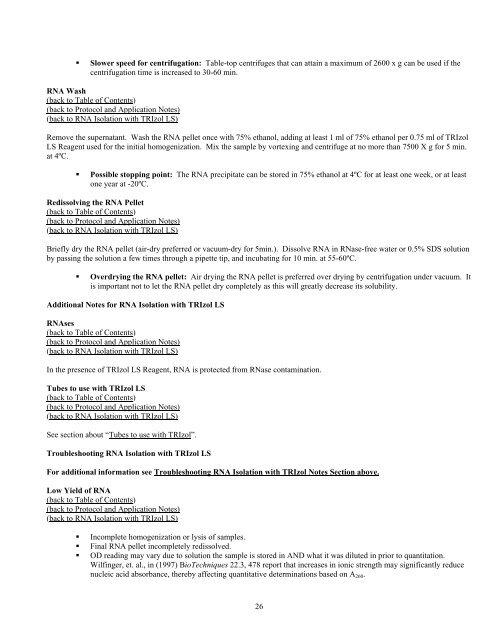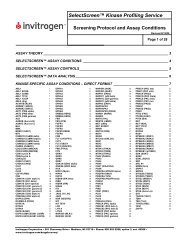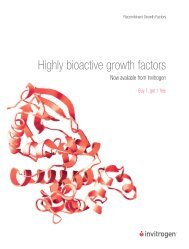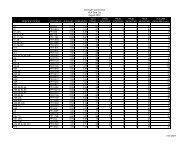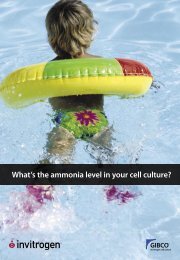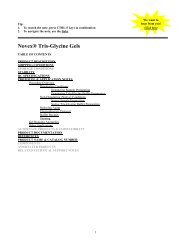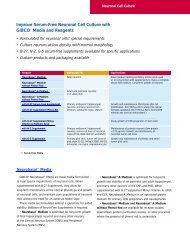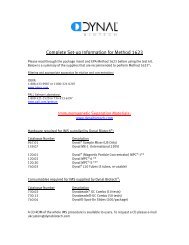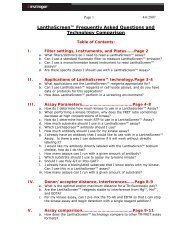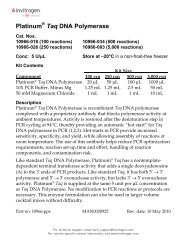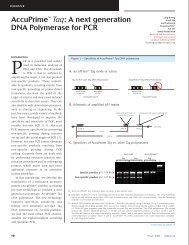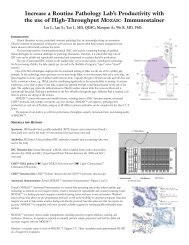TRIzol Reagent - Invitrogen
TRIzol Reagent - Invitrogen
TRIzol Reagent - Invitrogen
You also want an ePaper? Increase the reach of your titles
YUMPU automatically turns print PDFs into web optimized ePapers that Google loves.
Slower speed for centrifugation: Table-top centrifuges that can attain a maximum of 2600 x g can be used if the<br />
centrifugation time is increased to 30-60 min.<br />
RNA Wash<br />
(back to Table of Contents)<br />
(back to Protocol and Application Notes)<br />
(back to RNA Isolation with <strong>TRIzol</strong> LS)<br />
Remove the supernatant. Wash the RNA pellet once with 75% ethanol, adding at least 1 ml of 75% ethanol per 0.75 ml of <strong>TRIzol</strong><br />
LS <strong>Reagent</strong> used for the initial homogenization. Mix the sample by vortexing and centrifuge at no more than 7500 X g for 5 min.<br />
at 4ºC.<br />
Possible stopping point: The RNA precipitate can be stored in 75% ethanol at 4ºC for at least one week, or at least<br />
one year at -20ºC.<br />
Redissolving the RNA Pellet<br />
(back to Table of Contents)<br />
(back to Protocol and Application Notes)<br />
(back to RNA Isolation with <strong>TRIzol</strong> LS)<br />
Briefly dry the RNA pellet (air-dry preferred or vacuum-dry for 5min.). Dissolve RNA in RNase-free water or 0.5% SDS solution<br />
by passing the solution a few times through a pipette tip, and incubating for 10 min. at 55-60ºC.<br />
Overdrying the RNA pellet: Air drying the RNA pellet is preferred over drying by centrifugation under vacuum. It<br />
is important not to let the RNA pellet dry completely as this will greatly decrease its solubility.<br />
Additional Notes for RNA Isolation with <strong>TRIzol</strong> LS<br />
RNAses<br />
(back to Table of Contents)<br />
(back to Protocol and Application Notes)<br />
(back to RNA Isolation with <strong>TRIzol</strong> LS)<br />
In the presence of <strong>TRIzol</strong> LS <strong>Reagent</strong>, RNA is protected from RNase contamination.<br />
Tubes to use with <strong>TRIzol</strong> LS<br />
(back to Table of Contents)<br />
(back to Protocol and Application Notes)<br />
(back to RNA Isolation with <strong>TRIzol</strong> LS)<br />
See section about “Tubes to use with <strong>TRIzol</strong>”.<br />
Troubleshooting RNA Isolation with <strong>TRIzol</strong> LS<br />
For additional information see Troubleshooting RNA Isolation with <strong>TRIzol</strong> Notes Section above.<br />
Low Yield of RNA<br />
(back to Table of Contents)<br />
(back to Protocol and Application Notes)<br />
(back to RNA Isolation with <strong>TRIzol</strong> LS)<br />
Incomplete homogenization or lysis of samples.<br />
Final RNA pellet incompletely redissolved.<br />
OD reading may vary due to solution the sample is stored in AND what it was diluted in prior to quantitation.<br />
Wilfinger, et. al., in (1997) BioTechniques 22.3, 478 report that increases in ionic strength may significantly reduce<br />
nucleic acid absorbance, thereby affecting quantitative determinations based on A260.<br />
26


